First Flight:
Howard & Marty Benham
![]()
First Flight:
|
|
by Howard & Marty Benham
This article appeared in the September 1995 issue of the Falco Builders Letter. |
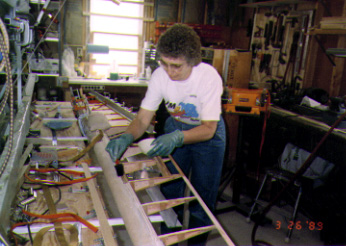
Marty Benham works on the elevator.
Our fascination with the Falco began long before the decision to build one. I liked the design the first time I saw it advertised in an aviation magazine. I cut out the ad and carried it in my billfold until it literally fell apart. When we decided it was time to build, the Falco seemed unattainable so we purchased plans for one of the Rutan composite airplanes (shame! shame!). Building a lay-up table was as far as that project went. After several moves, including one to Reykjavik, Iceland, we decided that if we were going to build one airplane in our lifetime, it would have to be a Falco and not one of those plastic airplanes!
Right before we left Iceland in the fall of 1988, we called Sequoia Aircraft and made an appointment to visit on the way to Wichita, Kansas where I had a new job with Flight Safety International at the Beech Aircraft factory. After a day spent with Alfred Scott inspecting Falco kits, trying on seats, talking design, etc., the three of us ended up in a Chinese restaurant still talking Falco. It was during dinner that I brought up the subject of external tanks for the Falco. I had heard that Alfred was a stickler for following the plans to the letter, and I figured that I might as well get it out up front that my dream was to be able to fly the Falco around the world. Much to my surprise, he took the suggestion rather calmly and we discussed several ways that the modifications might be made. The next morning we showed up at Sequoia bright and early and then went to the airport where Alfred keeps the Corporate Disgrace. After crawling over, under and around the "CD", we returned to the shop and purchased the plans for Falco serial #1057.
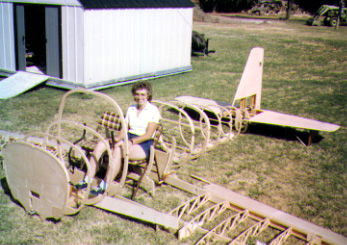
While Marty drove to Wichita, I perused the blueprints and read the construction manual out loud. Our Falco has been a joint project from the start, although at times Marty admits that the blueprints are a bit daunting. We worked together from the start of construction in February 1989 to first flight, June 30, 1995. During that period, we took a break from aircraft construction to build a house so N11HM took five-and-a-half years of pretty concentrated effort to complete. We started keeping a time log but after a month decided that it was a waste of time. The construction would take as long as it would take. When someone would ask us when the plane would be finished, we would say it was right on schedule and we should be finished Thursday. As it turned out, the final inspection by the FAA was on Thursday the 29th of June. After reviewing the many photos and visitors log, our best estimate for construction time is between 8000 and 9000 man/woman hours. We also determined that during construction we had over 240 individuals from 13 countries around the world and 22 states that wanted to see what a Falco looked like.
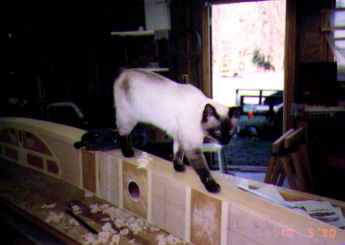
Quality control inspection of the main wing spar.
Construction was started in a heated 24 x 24 garage. We completed construction of the tail, wing and fuselage in that shop along with the wiring of the instrument panel. As with any project, we made several changes and additions to the aircraft as we went along but only after consulting with Alfred over possible effects. One of the most important additions was the hard points that had to be installed in the main wing spar and forward wing spar to support the external tanks. With the help of two talented engineers, one from Boeing and one from Beech, we were able to install the necessary attach points that would withstand an ultimate 9g vertical and 1g lateral load. With the addition of these tanks holding approximately 30 gallons, our friend from Beech calculates that our range at 45% power should be approximately 1500 nautical miles. It's funny how one change leads to another. After reviewing the figures for our extended range, my co-builder quietly informed me that the addition of a dual sex relief system, hereinafter known as the DSRS, would be mandatory. We have now designed a system which will be installed prior to the long range test flights. Fortunately, it will not be quite as difficult as the sticky plastic bags that Dick Rutan so eloquently describes in his talks about the Voyager flight. Another change that I felt was necessary was the addition of an avionics master switch. This consisted of swapping locations with two of the circuit breakers, cutting the main power bus bar and adding a normally closed solenoid, on/off switch and circuit breaker. We can't claim authorship on this design as Beech has used it for years on all of their aircraft. Just goes to show that even the "Spam cans" have some good ideas.
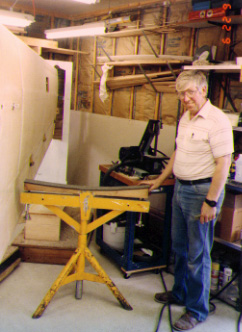
Howard Benham
At this point, we took a hiatus to build a new house, which is an entire story in itself. It was a lot of work, but like the Falco, it was worth it. We built the house around the plane. It is on a slight rise with the lower level opening onto a taxiway that leads to a 2500-foot grass runway. Once we finished the house, it was time to call upon a wonderful group of people from Flight Safety, the Kansas Aviation Museum and our local EAA chapter to help us move the Falco to its new home. Everyone had been following our progress with great interest and were more than happy to help. Also, they wanted to see how we would get the 9 foot wing/fuselage combination out through an 8 foot door. We didn't. Instead we took out a 10 foot section of the wall and moved it out through the opening and then reinstalled the wall. After that it was an hour and a half trip by back roads to the new hangar. We didn't realize it at the time, but once it was installed in the hangar it would be almost eight months before we finally started work again.
After almost a year of fitting the canopy, installing insulation, installing the beautiful interior that Marty had constructed and a myriad of other small projects that go into building an aircraft of this complexity, we were ready to call upon the "Friends of Falco" once again to turn the wing/fuselage unit upside-down so that the final fuselage skins could be installed and gear doors manufactured. At this point, a change was made to delete the inboard gear doors. This was done after talking to several of the builders that had inboard gear doors. Due to the difficulty that several of the builders had in adjusting these doors, we felt that any speed penalty would be minor and not worth the extra time and work. After constructing and fitting the main gear leg doors, nose gear bay doors and control surface hinge fairings, it was time to think paint.
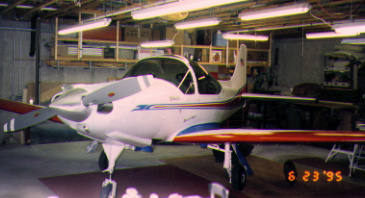
We had made the decision early on to do as much of the work as possible and in keeping with this we had decided to paint the aircraft ourselves using a new type of water-based polyurethane paint from Blue River Aircraft. This allowed us to construct a paint booth around the aircraft and paint it in the hangar using a low-pressure, low-volume paint gun. To decide on a paint scheme, we constructed a 1/10 scale model and tried about a dozen different designs before settling on the one we used. It is both patriotic and non-traditional. Following this, it was time to roll the Falco one more time to allow completion of the top side and complete final construction. During the next eight months, we installed a rebuilt 180 hp engine, fitted the cowling, painted the top half of the plane, balanced and installed the control surfaces and fitted the windshield.
During the construction, our goal had been to fly at the earliest possible date. However, in early 1994, a more definitive goal was set-Oshkosh '95. Our friends at Sequoia informed us that the first flight of the F.8L Falco was in June 1955 and in honor of that accomplishment it was decided to hold a birthday party at Oshkosh with as many Falcos present as possible. Now we really had a deadline to meet. Not only did we plan to go to Oshkosh with our own Falco, but we would also attempt to do our first flight during the first part of June, leaving us about a month and a half to finish up any last minute details. Enter the phenomena known as "the last week of construction takes a month." With a lot of long hours and help from friends, we were able to complete all of the tasks required to fly, provided we could get the final inspection by the FAA out of the way. Enter the bureaucratic process. "All inspectors are busy but we might be able to do the inspection on the 29th of June." With our fingers crossed, a call goes out once more to the "Friends of Falco" to assist in moving N11HM to the Augusta airport. We had decided to do the initial taxi and flight tests from this airport because of the 5000 foot paved runway and availability of fuel. On June 25th, thirteen hardy individuals showed up at 5:30 a.m. in the rain, to move N11HM. We rolled the plane onto a borrowed hay trailer and with several cars in front and several bringing up the rear, plus two-way communication between the towing vehicle and the wing watchers, the trip was completed without a hitch. On the 29th, the FAA showed up (on time!) and after an hour of inspecting, gave it their blessing. The only thing questioned during the inspection was the placement of the word "experimental".
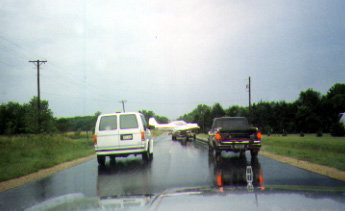
Friday, June 30th dawned hot and hazy. We had decided that I would do the first flights, which is one of Alfred's pet peeves. His standard position is that the builder should not do his own first flights, however, because I train pilots at Beech in the 1900 Airliner and had a chance to fly two other Falcos, I felt comfortable doing the first flights, although I'll admit there was a bit of adrenaline flowing during the first few minutes of the flight. Ed Merkel offered to fly chase in his Merkel Mark II biplane. Marty was in the front seat with the video camera and several instructors from Flight Safety showed up for the occasion. My parents had also arrived a couple of weeks earlier from Carlsbad, NM to help with the last minute details. My mother had decided that they would be here for the rollout but then they would have to leave. However, my dad was having none of that, as he had helped with some of the construction and wanted to see it fly. Ed and I planned and briefed all of the details of the flight ahead of time and everything went exactly as planned. The flight lasted about an hour and encompassed all the items recommended in the test guide, including a full stall series. If I had to describe the first flight in only a few words, I guess they would be "Wow, it was great!". The visibility is unbelievable, control response fabulous and acceleration great. Everything you could possibly want from the best designed airplane in the world.
During the first flight, we determined that we needed some trim on the right aileron and also a small amount of rudder trim. On the first of July, we completed the gear retraction tests and with Marty on board as necessary crew, we established the trim requirements for hands-off flight with two people and full fuel. This flight included landing at El Dorado airport for the EAA Chapter 88 annual fly-in, where we picked up the Ladies Choice award. Just goes to show that the women of Kansas have good taste when it comes to airplanes.
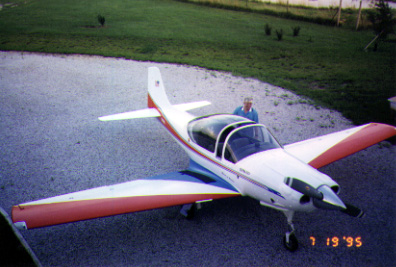
The next twenty-two days were rather hectic, but we managed to get all of the necessary flight testing completed and also get the pitot/static system and transponder certified for IFR flight. During the final few hours of flight testing we moved the Falco back to home base, Brady Pippen field, so that we could pack for Oshkosh. The end result of all the hard work was Sequoia Falco number 48 weighing in at 1300 pounds with a 180 hp. engine, constant speed prop and a B & C Specialties lightweight starter and alternator. The avionics panel currently houses an Apollo 618 loran, King KX155 nav/com and King KT 76A transponder. Future changes will see the loran replaced by a GPS, installation of a second communications unit, and installation of an Insight Graphic Engine Monitor.
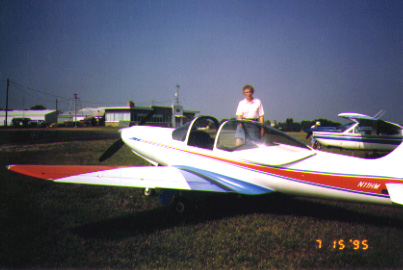
We departed Brady Pippen field on the 25th of July, spent the night at Casa de Aero in Illinois, and departed early Wednesday morning for Oshkosh. Arrival was uneventful, and we were directed to the area reserved for the Falcos. There were 5 there when we arrived but by Thursday morning the number had grown to a grand total of 18 beautiful Falcos all lined up near show center and as icing on the cake, the designer of the Falco, Dr. Stelio Frati and his sales manager, Carla Bielli arrived from Italy to help celebrate the occasion. While Dr. Frati was inspecting all of the Falcos, we were able to have him autograph N11HM.
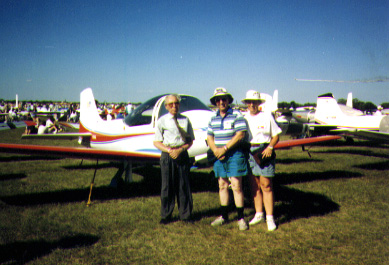
Stelio Frati with Howard and Marty at Oshkosh.
Several trips are already planned including the West Coast fly-in in Idaho. In the mean time, work will continue to get N11HM ready for the around-the-world flight. We have already lined up some sponsors, including the Kansas Aviation Museum, B & C Specialties, Sigma-Tek and Bevin Rabell Avionics. Much remains to be done, but with this wonderful aircraft and the great support of the aviation community, the goal of an around-the-world flight is very attainable. One word of caution to all our friends and fellow builders who have said from time to time that we should drop in and see you-the next time your phone rings, it may be Howard and Marty calling from the nearest airport.
Postscript: On Sunday, September 17, Howard Benham was taking a neighbor for a ride in the Falco. As he took off, he thinks the wind shifted. In any event, the right wing dropped. The Falco was not climbing, and it was clear that he was not going to clear the trees and power lines at the end of the runway, so he put it back on the ground. The airplane drove between two posts which buried themselves into the wing and then skidded another 40 feet or so before hitting a pair of large cedar trees. The airplane is completely destroyed. The harness held, and they stepped out of the plane unscathed. Alfred Scott |